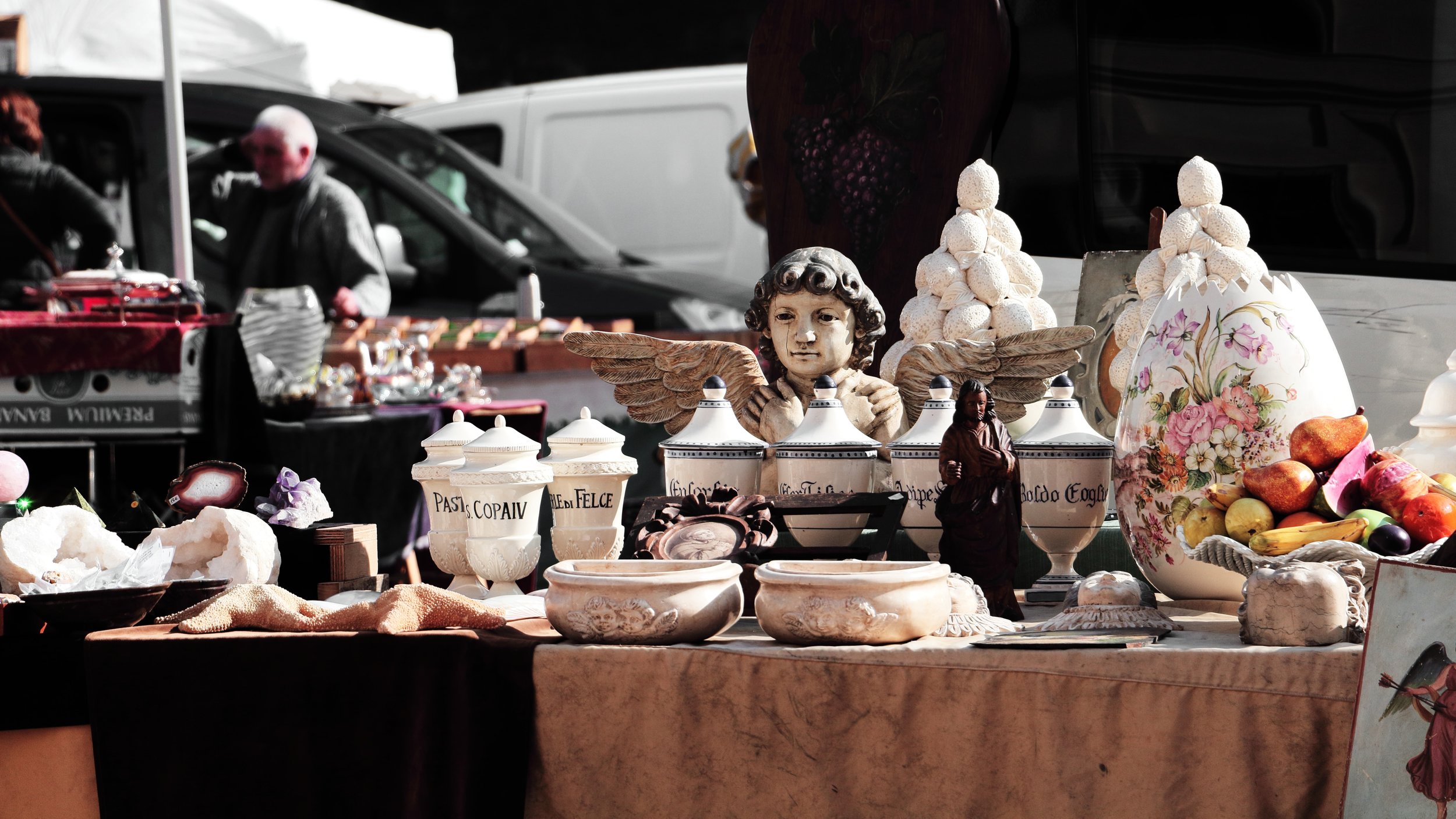Vintage Hunting 101: Mastering the Art of Garage Sale Treasure Hunting
Garage sales and vintage hunting are irresistible for treasure seekers and collectors alike. The prospect of stumbling upon hidden gems, unique antiques, or nostalgic relics amid the array of items on display is a thrilling adventure. These pursuits offer the chance to find valuable treasures and glimpse into each vintage item's stories and history.
Amidst the apparent chaos of garage sales, there lies a remarkable opportunity for collectors and vintage enthusiasts. What may seem like a jumble of old belongings is a treasure trove of hidden gems waiting to be uncovered. Among the mismatched dishes, dusty books, and forgotten toys, valuable vintage items often lie in plain sight, patiently awaiting discovery.
In this blog post, we will explore the tips and tricks for successfully navigating garage sales and unearthing vintage treasures that can breathe new life into your collections or your home's decor.
Preparation is Key
Before embarking on your garage sale adventure, thorough preparation can significantly enhance your chances of finding valuable vintage items. Here are some critical steps to take:
Research Sales in Advance
Scout local newspapers, online classifieds, and garage sale apps to identify upcoming sales.
Create a list of sales, noting their addresses, opening times, and any specific items of interest mentioned in the listings.
Plan Your Route
Arrange the sales geographically to minimize travel time between them.
Based on your research, consider starting with the sales that will likely have the most promising vintage items.
If you're visiting unfamiliar neighborhoods, have a map or GPS device to help you navigate.
Prepare Cash and Change
Many garage sales only accept cash. Ensure you have enough small bills and change for purchases.
Bring Essential Tools & Resources
Pack a flashlight for inspecting items in dimly lit areas or garages.
Consider bringing a measuring tape, a magnifying glass, and a smartphone to research items on the spot.
Carry bags or boxes to transport your finds safely, which helps prevent damage during transit.
Pack a bottle of water, sunscreen, snacks, and hand sanitizer to stay comfortable and refreshed.
Dress Appropriately
Choose comfortable clothing and shoes suitable for walking, standing, and potentially crouching or kneeling. Comfortable sneakers or walking shoes are often the best choices.
Wear layers you can easily add or remove as the weather changes. Mornings at garage sales can be cool, but it may get warmer later in the day.
Check the weather forecast and dress accordingly. If it's sunny, wear a hat, sunglasses and sunscreen. If it might rain, bring a lightweight waterproof jacket.
A crossbody bag or fanny pack can be convenient for keeping your hands free while shopping.
Set a Budget
Before heading out, decide how much you're willing to spend. Consider your financial situation and what you can comfortably afford.
Divide your total budget into categories if you're looking for specific items. For example, allocate a portion for vintage clothing, another for collectibles, and so on.
Charge Your Devices
Ensure your phone is fully charged to look up information or contact sellers.
Bring a List of Desired Items
Decide which items are your top priorities and allocate a more significant portion of your budget to those. You can be more flexible with things of lower importance.
If you find something you love but it's outside your budget, resist the temptation to overspend. Politely walk away and stick to your financial plan.
By taking these preparatory steps, you'll be well-equipped for a successful and enjoyable day of garage sale treasure hunting. Remember that research, planning, and readiness can turn a cluttered garage into a goldmine of vintage finds.
Photo by Simone Pellegrini on Unsplash
Arrive Early
Arriving early to a garage sale can be the key to unlocking hidden treasures and securing the best finds. Here's why being an early bird is crucial:
First Pick of Items
Garage sales typically follow the principle of "first come, first served." The early bird not only gets the worm but also gets the first pick of items.
Valuable vintage items, collectibles, and sought-after pieces attract attention quickly. Arriving early increases your chances of snagging these gems before someone else does.
Limited Competition
By arriving early, you face less competition from other buyers. As the day progresses, more bargain hunters join the fray, making securing the most desirable items harder.
Negotiating Advantage
Sellers at garage sales may be more willing to negotiate prices with early shoppers. They might be eager to clear out items and offer better deals in the morning.
Better Condition Finds
Early birds have the advantage of finding items in better condition. Things may get handled as the day goes on, and the best pieces may suffer wear and tear.
Efficient Planning for Multiple Sales
Arriving early doesn't mean rushing mindlessly to the nearest garage sale. Efficient planning is crucial in maximizing your opportunities:
Prioritize Sales: Plan your route based on the sales you've researched and prioritize the ones likely to have the items you seek.
Start Strategically: Begin with the sales that open earliest and are closest to your location. This ensures you have the best chance of being among the first shoppers.
Have a Backup Plan: Garage sales can be unpredictable. If you arrive at a sale and it doesn't meet your expectations, have backup sales on your list to visit.
In essence, arriving early is a strategy that can give you a significant advantage in the competitive world of garage sales. It allows you to choose from a more comprehensive selection, negotiate more effectively, and secure the vintage treasures you seek before they slip into someone else's hands.
Photo by Bianca Fazacas on Unsplash
Inspect Thoroughly
Having a keen eye for detail is an invaluable skill for vintage collectors. It can mean distinguishing between discovering a hidden gem and acquiring a disappointing one. Here's why a keen eye for detail is essential, along with tips for inspecting vintage items for quality, authenticity, and condition:
Importance of a Keen Eye for Detail:
Authenticity Verification: Vintage markets can be rife with reproductions and counterfeits. A keen eye helps you spot telltale signs of authenticity and avoid costly mistakes.
Quality Assessment: Not all vintage items are created equal. Being detail-oriented allows you to accurately assess the quality of materials, craftsmanship, and overall condition.
Value Determination: Minor details, such as the maker's marks, signatures, or specific design elements, can significantly affect an item's value. Recognizing these details helps you make informed decisions.
Tips for Inspecting Vintage Items
Research Beforehand: Familiarize yourself with the specific vintage items or categories you're interested in. Know the key characteristics, marks, and features that indicate authenticity and quality.
Look for Maker's Marks and Signatures: Genuine vintage items often bear marks or signatures from manufacturers, artists, or designers. Research these marks to confirm authenticity.
Examine Materials: Assess the materials used in the item's construction. For example, natural wood, solid metal, and quality fabrics often indicate higher quality.
Check for Wear and Tear: Vintage items are, by definition, not new. Expect some wear, but inspect for excessive damage or repairs affecting usability or value.
Inspect for Originality: Verify if an item has been altered, restored, or refinished. Original vintage pieces tend to hold more value/
Ask Questions: Ask sellers about an item's history, provenance, and any known issues. A reputable seller should provide transparent information.
Use a Magnifying Glass: For small details, like fine print, signatures, or tiny imperfections, a magnifying glass can be beneficial.
Trust Your Senses: Touch, smell, and listen when appropriate. For example, the scent can help detect musty odors indicating mold or mildew, and a gentle tap can reveal loose or damaged parts.
Assess Structural Integrity: Ensure that moving parts function correctly, and assess the structural integrity of items like furniture or ceramics.
Compare and Document: If possible, compare the item you're considering with reference images or similar pieces online. Document your findings with photos and notes.
Be Patient: Take your time with the inspection process. Take your time to thoroughly assess an item before making a decision.
Seek Expert Opinions: When in doubt or when considering high-value purchases, consider consulting experts or appraisers in the relevant field.
Negotiate Diplomatically
Negotiating diplomatically is not just about getting a good deal; it's about fostering positive interactions and leaving you and the seller satisfied with the outcome. Starting with a friendly approach, making reasonable offers, and showing respect throughout the process enhance your vintage collecting experiences and build good relationships with sellers.
Start with a Friendly Greeting: Begin the negotiation with a warm and friendly greeting. A simple "Hello" or "Good morning" can set a positive tone for the conversation.
Build Rapport: Take a moment to chat with the seller about the item or even share a brief anecdote. This establishes a connection and shows genuine interest.
Ask Open-Ended Questions: Encourage the seller to discuss the item's history, condition, or exciting details. This not only helps you gather information but also shows your sincere interest.
Express Appreciation: Compliment the item and express appreciation for its uniqueness or quality. This can create a positive atmosphere.
Make Reasonable Offers: When discussing the price, be prepared to make reasonable offers based on your research and the item's condition. Start with a polite request, such as, "Would you consider $X for this?"
Be Prepared to Justify Your Offer: If the seller hesitates, be ready to explain why you believe your offer is fair. Mention any flaws or factors that might justify a lower price.
Be Patient and Respectful: Give the seller time to think and respond. Avoid rushing or appearing impatient. Maintain a respectful tone throughout the negotiation.
Don't Lowball: While it's essential to haggle, avoid making meager offers that might offend the seller. Instead, aim for a reasonable compromise.
Be Flexible: Be open to negotiation and compromise. If the seller counters with a different price, consider it and be willing to adjust your offer accordingly.
Know When to Walk Away: If the seller's price is far from what you're willing to pay, it's okay to thank them and say you'll think about it politely. Sometimes, walking away can lead to a better offer.
Stay Calm and Polite: Even if negotiations become challenging, maintain your composure and politeness. Getting frustrated or confrontational rarely leads to a successful outcome.
Practice Active Listening: Respond to the seller's responses and body language. This can provide valuable insights into their willingness to negotiate.
Seal the Deal Gracefully: Once you've agreed on a price, express your gratitude and complete the transaction with a smile and a "Thank you."
Practice Patience
Collecting vintage items is like embarking on a thrilling treasure hunt. But unlike a quick sprint, it's more of a long-distance run. Building a valuable and meaningful collection may take months or even years.
Persistence is key. Not every garage sale or antique store visit will yield remarkable finds. There will be days when you come up empty-handed, but that's part of the journey.
The garage sale world offers collectors and enthusiasts an exciting and rewarding adventure. Every event is a new opportunity to uncover unique, valuable, and nostalgic treasures to enrich your collection and life. So, put on your comfortable shoes, grab your budget, and hit the road—your next vintage gem might be just around the corner! Happy hunting!




